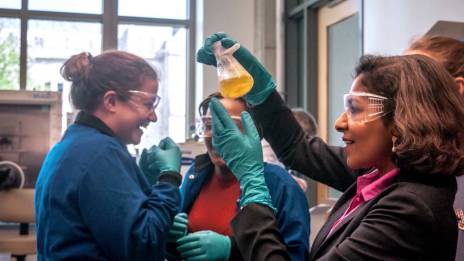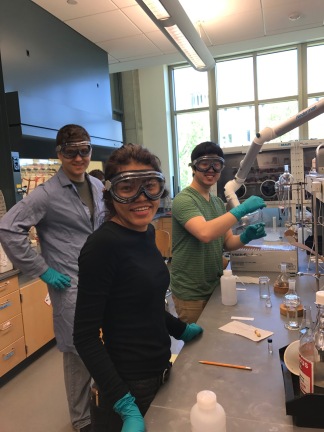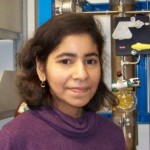CUR Chem is bringing you real life stories from the trenches of summer research with undergraduates. This week we peek into the Kalyani research lab an St. Olaf College, where they “make it happen”.
Words to live by

If you want to find the Organometallic Chemistry Kalyani research lab, walk into Regents Hall, the science building here at St. Olaf, and follow the music, which is playing in lab the vast majority of the time. We have fun, while we “make it happen” (the group motto). Indeed, something is always happening in lab — even though mostly during the summer due to the busy schedule everyone has during the academic year.

I started my academic career at St. Olaf in Fall 2011 and received tenure and promotion to the associate professor earlier this year. Over the past six years I have mentored about 50 undergraduate students. About 30 of these students have participated in the ten-week summer research program in my lab. This summer I have six energetic and enthusiastic students working with me. These students and their projects are being supported by the NSF, NIH, Research Corporation and Dreyfus grants that are currently funding the Kalyani Lab.
Peer mentoring works
A hallmark of the Kalyani Research Lab is peer learning. I maintain a group that has a mix of experienced and novice researchers. This is no different this summer. Zubaoyi (Bowie) Yi is the senior most member and has been doing research with me since Spring 2015. She is assisting me with projects and training the other students on techniques before leaving for China in mid July. She will be starting graduate school at the University of Illinois at Urbana Champaign in the Fall. Ryan Walser Kuntz has been in my lab since the past year. Jason Dickmeyer, Sarah Kolling, and Erin Plasek started in the lab in February 2017. Sonam Palmo is the newest member and started with us this summer, just 1.5 weeks ago.

While I trained my first group of research students in lab, the rest have primarily been trained by peers. Novice researchers joining my lab are paired with more experienced research students. When Jason, Sarah, and Erin joined the lab early this year, they were all partnered with other students who had already been trained on much of our equipment and procedures. Sonam, our newest addition, joined the research group at the beginning of the summer. In the few short months that they have been working in the lab, Jason, Sarah and Erin have gained enough experience to help Sonam with more simple procedures. The most experienced researchers Bowie and Ryan are instrumental this summer in helping Jason, Sarah, Erin and Sonam. It is a joy to see the students gradually evolve into mentors as they devote more time to research.
While students are working in teams, they each take ownership of a small aspect of their projects.

Sonam, Ryan and Jason are working as a team while Sarah and Erin are paired on another project. Bowie is starting up new projects and is assisting me in finishing a manuscript. While students are working in teams, they each take ownership of a small aspect of their projects.
…superstitions are welcome in the lab, and they make the lab more entertaining, if nothing else…
Both the mentorship and teamwork in Kalyani lab creates an environment that is productive, efficient, and fun. The students often become close friends, as they spend so much time working together, making the atmosphere of lab full of inside jokes and nicknames. The students and I share wisdom regarding how to work with specific chemicals. Sometimes these tips are not completely scientific and include verbally persuading the chemical to comply to your needs; however, superstitions are welcome in the lab, and they make the lab more entertaining, if nothing else.
The PI’s role
If students train each other one might wonder what my role is? I occasionally do still help students with techniques as needed. My major contribution is decision making for projects. Right now, in the beginning of the summer, every morning I talk to students regarding their data from the previous day and their to-do-lists for the day. Eventually as the summer progresses, students will make their own to-do-lists and will assume more ownership of their projects. I also set the standards for the notebook and data keeping in the beginning of the summer and check that students are adhering to these standards throughout till it comes naturally to them
Right now, in the beginning of the summer, every morning I talk to students regarding their data from the previous day and their to-do-lists for the day.
Past summers I was busy writing grants and publications. This summer I am hoping to submit one manuscript and am not writing any grants. I will also spend time reading the literature to initiate new directions for the research projects. I will also be travelling to the Great Lakes Regional ACS meeting later this month to give a research talk.
First week of the summer is a steep learning curve and a lot of mess ups happen. Students have learned a lot in the past 1.5 weeks both from their accomplishments and their mistakes. I am looking forward to seeing these students take the driver’s seat for their projects as the summer progresses.
 ~Dr. Dipa Kalyani is an Associate Professor of Chemistry at St. Olaf College where her research with undergraduates focuses on the discovery of greener and more economical processes for the construction of molecular architectures commonly found in many chemicals.
~Dr. Dipa Kalyani is an Associate Professor of Chemistry at St. Olaf College where her research with undergraduates focuses on the discovery of greener and more economical processes for the construction of molecular architectures commonly found in many chemicals.




[…] this first post, we learned about the Kalyani lab philosophy of summer research – “Make it […]
LikeLike
[…] more highly-motivated students. In my group we took advantage of the peer mentoring approach (as Dr. Kalyani also pointed out earlier in her ChemCUR post. This approach helped to grow our team to eight students. Students worked on our research projects […]
LikeLike